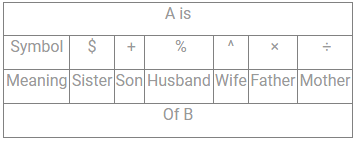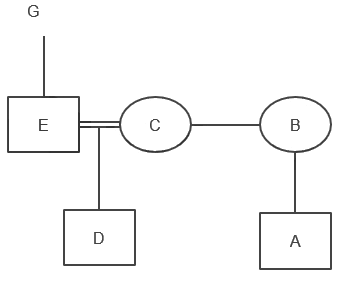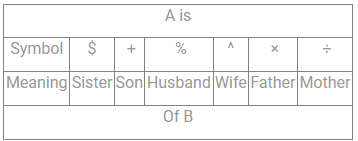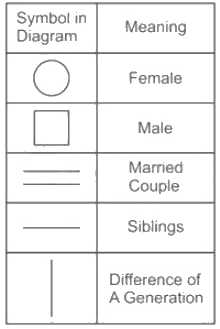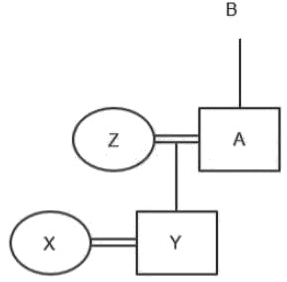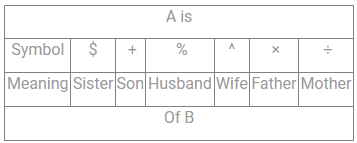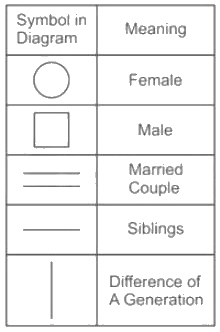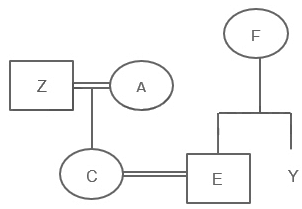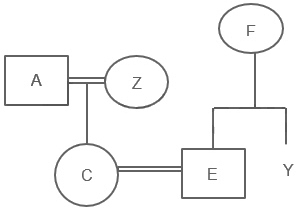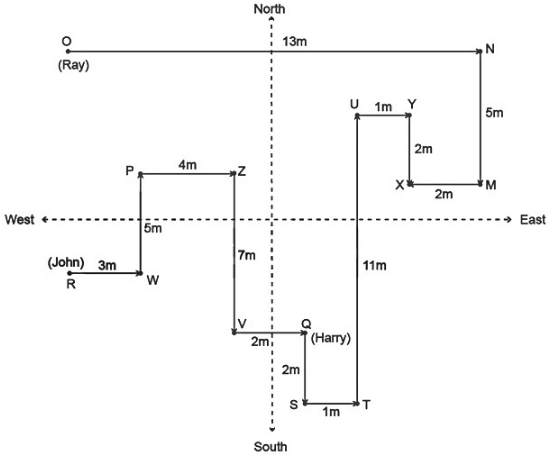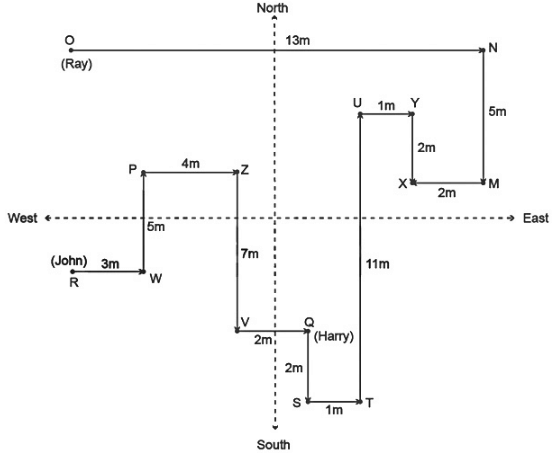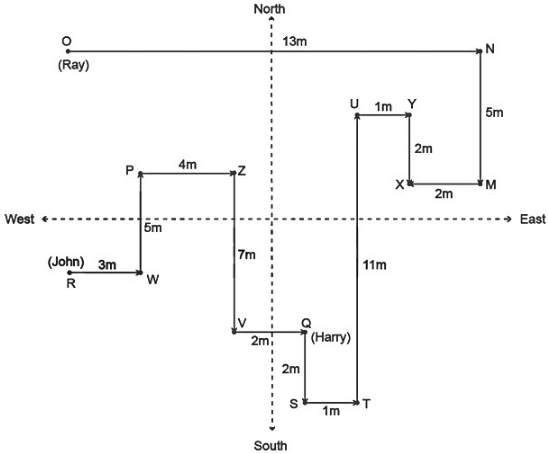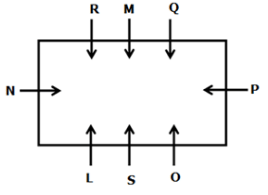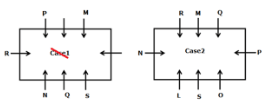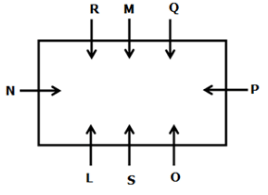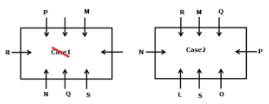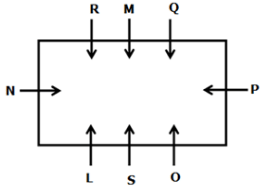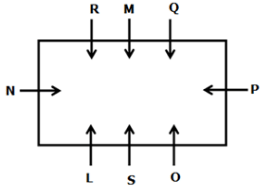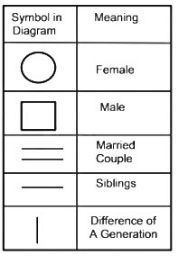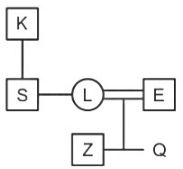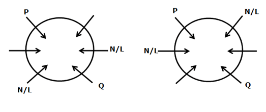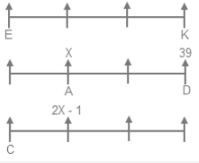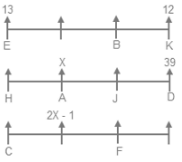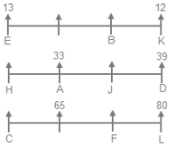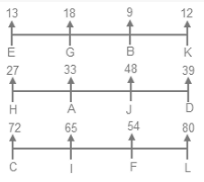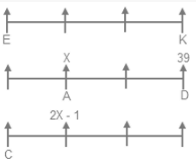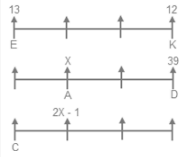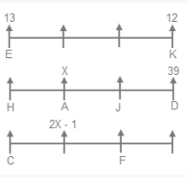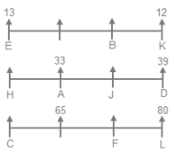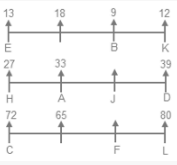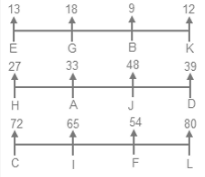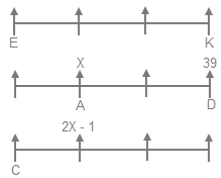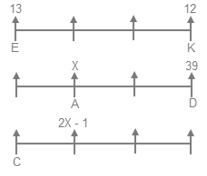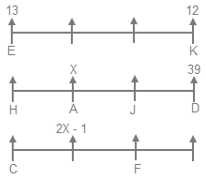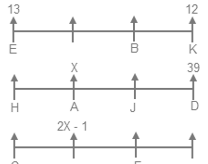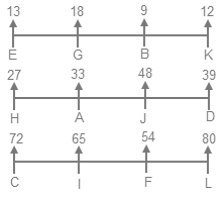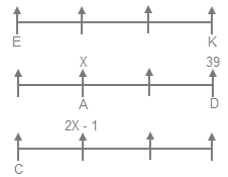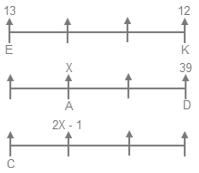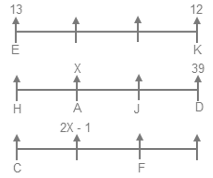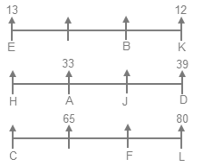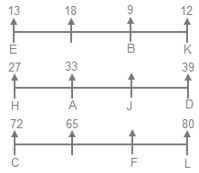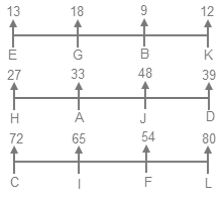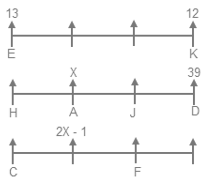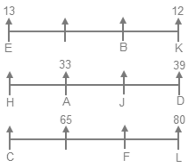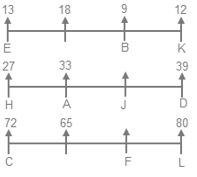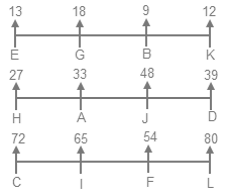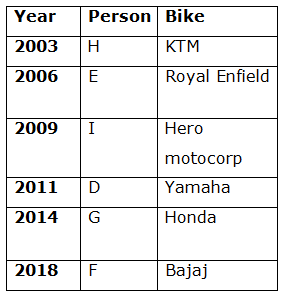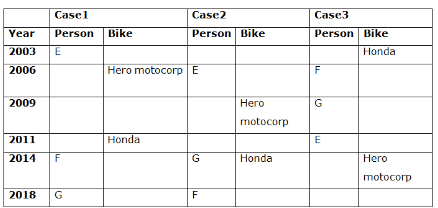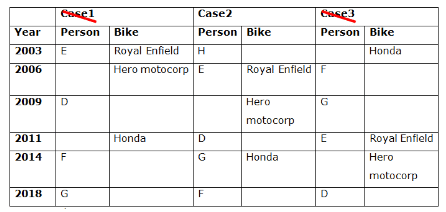RBI Assistant Mains Mock Test - 7 - Bank Exams MCQ
30 Questions MCQ Test - RBI Assistant Mains Mock Test - 7
Select the one which is different from the other four responses.
Study the following information carefully and answer the below questions
A Nine letter word (may or may not be meaningful) with no repeated letters is arranged in two arrangements to form the series. The same letters are used in each of the arrangements.
Arrangement 1:
A is placed fourth to the right of G. Only one letter is placed between G and B. B is placed to the left of G. The number of letters placed to the left of G is one less than the number of letters placed to the right of U. Only two letters are placed between U and T which is placed either at the left end or right end. I is placed second to the right of S. E is placed to the left of C. C and I are not placed adjacent to each other.
Arrangement 2:
The first and last letters along with the fourth letter from the right end in arrangement 1 are taken to form the first meaningful word. U is immediate left of T. The third letter from both the left end and right end along with the second letter from the left end in arrangement 1 are taken to form a second meaningful word. S is placed to the right of A. The remaining letters are arranged in such a way to form the third meaningful word.
Which of the following letter is placed fifth from the left end in Arrangement 1?
Study the following information carefully and answer the below questions
A Nine letter word (may or may not be meaningful) with no repeated letters is arranged in two arrangements to form the series. The same letters are used in each of the arrangements.
Arrangement 1:
A is placed fourth to the right of G. Only one letter is placed between G and B. B is placed to the left of G. The number of letters placed to the left of G is one less than the number of letters placed to the right of U. Only two letters are placed between U and T which is placed either at the left end or right end. I is placed second to the right of S. E is placed to the left of C. C and I are not placed adjacent to each other.
Arrangement 2:
The first and last letters along with the fourth letter from the right end in arrangement 1 are taken to form the first meaningful word. U is immediate left of T. The third letter from both the left end and right end along with the second letter from the left end in arrangement 1 are taken to form a second meaningful word. S is placed to the right of A. The remaining letters are arranged in such a way to form the third meaningful word.
How many letters are between T and I in Arrangement 2?
Study the following information carefully and answer the below questions
A Nine letter word (may or may not be meaningful) with no repeated letters is arranged in two arrangements to form the series. The same letters are used in each of the arrangements.
Arrangement 1:
A is placed fourth to the right of G. Only one letter is placed between G and B. B is placed to the left of G. The number of letters placed to the left of G is one less than the number of letters placed to the right of U. Only two letters are placed between U and T which is placed either at the left end or right end. I is placed second to the right of S. E is placed to the left of C. C and I are not placed adjacent to each other.
Arrangement 2:
The first and last letters along with the fourth letter from the right end in arrangement 1 are taken to form the first meaningful word. U is immediate left of T. The third letter from both the left end and right end along with the second letter from the left end in arrangement 1 are taken to form a second meaningful word. S is placed to the right of A. The remaining letters are arranged in such a way to form the third meaningful word.
What is the position of U from the right end in Arrangement 1?
Study the following information carefully and answer the below questions
A Nine letter word (may or may not be meaningful) with no repeated letters is arranged in two arrangements to form the series. The same letters are used in each of the arrangements.
Arrangement 1:
A is placed fourth to the right of G. Only one letter is placed between G and B. B is placed to the left of G. The number of letters placed to the left of G is one less than the number of letters placed to the right of U. Only two letters are placed between U and T which is placed either at the left end or right end. I is placed second to the right of S. E is placed to the left of C. C and I are not placed adjacent to each other.
Arrangement 2:
The first and last letters along with the fourth letter from the right end in arrangement 1 are taken to form the first meaningful word. U is immediate left of T. The third letter from both the left end and right end along with the second letter from the left end in arrangement 1 are taken to form a second meaningful word. S is placed to the right of A. The remaining letters are arranged in such a way to form the third meaningful word.
Which of the following word is not in Arrangement2?
I. BUT
II. TUB
III. ICE
IV. SAG
Directions: Study the following information carefully to answer the given questions:
If ‘A + B’ means ‘A is the son of B’.
If ‘A × B’ means ‘A is the father of B’.
If ‘A % B’ means ‘A is the husband of B’.
If ‘A ÷ B’ means ‘A is the mother of B’.
If ‘A $ B’ means ‘A is the sister of B’.
If ‘A ^ B’ means ‘A is the wife of B’.
Which of the following options is true if the expression ‘A + B $ C ÷ D + E + G’ is definitely true?
Directions: Study the following information carefully to answer the given questions:
If ‘A + B’ means ‘A is the son of B’.
If ‘A × B’ means ‘A is the father of B’.
If ‘A % B’ means ‘A is the husband of B’.
If ‘A ÷ B’ means ‘A is the mother of B’.
If ‘A $ B’ means ‘A is the sister of B’.
If ‘A ^ B’ means ‘A is the wife of B’.
Which of the following options is true if the expression ‘X ^ Y + Z ^ A + B’ is definitely true?
Directions: Study the following information carefully to answer the given questions:
If ‘A + B’ means ‘A is the son of B’.
If ‘A × B’ means ‘A is the father of B’.
If ‘A % B’ means ‘A is the husband of B’.
If ‘A ÷ B’ means ‘A is the mother of B’.
If ‘A $ B’ means ‘A is the sister of B’.
If ‘A ^ B’ means ‘A is the wife of B’.
Which of the given expressions indicates that Y is the sister-in-law of C?
If all digits are added within the number then which of the following options, the resultant value will be a prime number if we subtract the lowest and highest number thus formed in each row?
I. 2586, 9836, 4276
II. 1863, 8521, 7693
III. 6971, 4862, 3586
What will come in the place of question mark(?).
1,?,6,21,88,445
In each question below is a given letter followed by four combinations of symbols and numbers. You have to find out which of the combination correctly represents the code based on the given coding system.

Conditions:
i) If the first and last letters are consonants, then both are to be coded as the code of the last letter.
ii) If the first letter is consonant and the last letter is a vowel, then both are to be coded as the code of the first letter.
iii) If the first letter and last letter are vowels, then the codes of both are to be interchanged.
iv) If the first letter is the vowel and the last letter is consonant, then both are to be coded as “+”
What does "ACTIVE" represent in a code language?
In each question below is a given letter followed by four combinations of symbols and numbers. You have to find out which of the combination correctly represents the code based on the given coding system.

Conditions:
i) If the first and last letters are consonants, then both are to be coded as the code of the last letter.
ii) If the first letter is consonant and the last letter is a vowel, then both are to be coded as the code of the first letter.
iii) If the first letter and last letter are vowels, then the codes of both are to be interchanged.
iv) If the first letter is the vowel and the last letter is consonant, then both are to be coded as “+”
What does '!^*81!' represent in the given language?
In each question below is a given letter followed by four combinations of symbols and numbers. You have to find out which of the combination correctly represents the code based on the given coding system.

Conditions:
i) If the first and last letters are consonants, then both are to be coded as the code of the last letter.
ii) If the first letter is consonant and the last letter is a vowel, then both are to be coded as the code of the first letter.
iii) If the first letter and last letter are vowels, then the codes of both are to be interchanged.
iv) If the first letter is the vowel and the last letter is consonant, then both are to be coded as “+”
What does "PACKED DAMAGE" represent in a code language?
In each question below is a given letter followed by four combinations of symbols and numbers. You have to find out which of the combination correctly represents the code based on the given coding system.

Conditions:
i) If the first and last letters are consonants, then both are to be coded as the code of the last letter.
ii) If the first letter is consonant and the last letter is a vowel, then both are to be coded as the code of the first letter.
iii) If the first letter and last letter are vowels, then the codes of both are to be interchanged.
iv) If the first letter is the vowel and the last letter is consonant, then both are to be coded as “+”
What does '+4!&3+ ?7@98?' represent in the given language?
Direction: Study the following information and answer the questions following.
John starts walking from point R in east direction. After walking 3 m he turns left from point W and walks for 5 m. He then turns right from point P and walks for 4 m, he then turns right from point Z and walks for 7 m. He then turns left from point V and walks for 2 m till point Q. Ray started walking from point O in east direction. After walking 13 m he turns right from point N and walks for 5 m. He then right from point M and walks for 2 m till point X. Harry started walking from point Q in south direction. After walking 2 m he turns left from point S and walks for 1 m and then turns left from point T and walks for 11 m. He then turns right from point U and walks for 1 m and then turns right from point Y and walks for 2 m till point X.
If Ray walks 2 m from point X in east direction and then turns right from point M and walks 5 m till point A. John walks 2 m in east from point Q and then turns right and walks till point T. What is the shortest distance between T and A?
Direction: Study the following information and answer the questions following.
John starts walking from point R in east direction. After walking 3 m he turns left from point W and walks for 5 m. He then turns right from point P and walks for 4 m, he then turns right from point Z and walks for 7 m. He then turns left from point V and walks for 2 m till point Q. Ray started walking from point O in east direction. After walking 13 m he turns right from point N and walks for 5 m. He then right from point M and walks for 2 m till point X. Harry started walking from point Q in south direction. After walking 2 m he turns left from point S and walks for 1 m and then turns left from point T and walks for 11 m. He then turns right from point U and walks for 1 m and then turns right from point Y and walks for 2 m till point X.
If Harry starts walking from point X in west direction and after walking 11 m he turns left and walks 5 m. He then turns left and walks for 3 m and stops, then Harry reaches which point?
Direction: Study the following information and answer the questions following.
John starts walking from point R in east direction. After walking 3 m he turns left from point W and walks for 5 m. He then turns right from point P and walks for 4 m, he then turns right from point Z and walks for 7 m. He then turns left from point V and walks for 2 m till point Q. Ray started walking from point O in east direction. After walking 13 m he turns right from point N and walks for 5 m. He then right from point M and walks for 2 m till point X. Harry started walking from point Q in south direction. After walking 2 m he turns left from point S and walks for 1 m and then turns left from point T and walks for 11 m. He then turns right from point U and walks for 1 m and then turns right from point Y and walks for 2 m till point X.
What is the direction of final point of John with respect to Ray’s final point?
Direction: Study the following information and answer the questions following.
John starts walking from point R in east direction. After walking 3 m he turns left from point W and walks for 5 m. He then turns right from point P and walks for 4 m, he then turns right from point Z and walks for 7 m. He then turns left from point V and walks for 2 m till point Q. Ray started walking from point O in east direction. After walking 13 m he turns right from point N and walks for 5 m. He then right from point M and walks for 2 m till point X. Harry started walking from point Q in south direction. After walking 2 m he turns left from point S and walks for 1 m and then turns left from point T and walks for 11 m. He then turns right from point U and walks for 1 m and then turns right from point Y and walks for 2 m till point X.
What is the shortest distance between Ray’s and John’s initial point?
Study the following information carefully and answer the below questions
Eight persons- L, M, N, O, P, Q, R, and S are sitting on the rectangular table facing the center but not necessarily in the same order. Three of them sit at each longer side and one of them sits at each smaller side of the table.
N sits second to the left of the one who sits opposite to M. M sits on the longer side of the table. One person sits between N and S. The number of persons sit between M and S is the same as the number of persons sit between N and P when counted from the right of both M and N. The one who sits immediate left of S sits second to the right of R. The number of persons sit between R and M is same as the number of persons sit between M and Q. Q sits adjacent to either N or P. L neither sits adjacent to P nor M.
What is the position of L with respect to P?
Study the following information carefully and answer the below questions
Eight persons- L, M, N, O, P, Q, R, and S are sitting on the rectangular table facing the center but not necessarily in the same order. Three of them sit at each longer side and one of them sits at each smaller side of the table.
N sits second to the left of the one who sits opposite to M. M sits on the longer side of the table. One person sits between N and S. The number of persons sit between M and S is the same as the number of persons sit between N and P when counted from the right of both M and N. The one who sits immediate left of S sits second to the right of R. The number of persons sit between R and M is same as the number of persons sit between M and Q. Q sits adjacent to either N or P. L neither sits adjacent to P nor M.
Four of the five among the following are similar in such a way to form a group, who among the following doesn’t belong to the group?
Study the following information carefully and answer the below questions
Eight persons- L, M, N, O, P, Q, R, and S are sitting on the rectangular table facing the center but not necessarily in the same order. Three of them sit at each longer side and one of them sits at each smaller side of the table.
N sits second to the left of the one who sits opposite to M. M sits on the longer side of the table. One person sits between N and S. The number of persons sit between M and S is the same as the number of persons sit between N and P when counted from the right of both M and N. The one who sits immediate left of S sits second to the right of R. The number of persons sit between R and M is same as the number of persons sit between M and Q. Q sits adjacent to either N or P. L neither sits adjacent to P nor M.
How many persons are sitting between L and R when counted from the left of L?
Study the following information carefully and answer the below questions
Eight persons- L, M, N, O, P, Q, R, and S are sitting on the rectangular table facing the center but not necessarily in the same order. Three of them sit at each longer side and one of them sits at each smaller side of the table.
N sits second to the left of the one who sits opposite to M. M sits on the longer side of the table. One person sits between N and S. The number of persons sit between M and S is the same as the number of persons sit between N and P when counted from the right of both M and N. The one who sits immediate left of S sits second to the right of R. The number of persons sit between R and M is same as the number of persons sit between M and Q. Q sits adjacent to either N or P. L neither sits adjacent to P nor M.
Which of the following statement is/are true?
I. N and P does not sit opposite to each other
II. Q sits second to the right of O.
III. L and M are immediate neighbors
Directions: Study the following information carefully to answer the given questions:
If 'A + B' means 'A is the brother of B'
If 'A $ B' means 'A is the sister of B'
If 'A % B' means 'A is the son of B'
If 'A & B' means 'A is the father of B'
If 'A # B' means 'A is the mother of B'
How is K related to E in the expression 'K & S + L # Z % E & Q’?
Each of the questions below consists of a question and two statements numbered I and II given below it. You have to decide whether the data provided in the statements are sufficient to answer the question:
Six persons- L, M, N, O, P, and Q are sitting on the circular table facing the center but not necessarily in the same order. Who sits third to the right of N?
Statement I: P sits second to the left of M. Only two persons sit between M and L. Q sits immediate left of O.
Statement II: The number of persons who sit between N and Q is the same as the number of persons who sit between Q and L. P sits opposite to Q.
Direction: Read the instructions carefully and answer the question below.
Twelve people of a family, A, B, C, D, E, F, G, H, I, J, K, and L are sitting in three rows facing north. Each row has four seats at equal distance. The seats of these rows are arranged in such a way that the first seat of the first row is exactly in front of the first seat of the second row and the first seat of the second row is exactly in front of the first seat of the third row and so on. Also, these people are sitting in such a way that the people sitting in the first row are younger than 20 years, the people sitting in the row immediately behind it i.e. row 2 are older than 20 years but younger than 50 years and the people sitting in the row that is immediately behind row 2 are older than 50 years. Also, the age of each of these people is a natural number.
J is 6 years younger than F but 30 years younger than G. The difference between the ages of A and L is 47 years. The age of B is one third the age of the person who is sitting immediately behind E but half the age of the person who is sitting to his immediate left. The difference between the ages of the two people who are sitting on the extreme ends in the third row is 8 years. The age of H is 45 years less than the person sitting immediately behind him. L is 15 years older than the person who is sitting second to his left. J is sitting immediately in front of F. B is sitting to the immediate left of the person who is sitting right in front of D. E is sitting two seats ahead of C whose age is numerically an even number. H is sitting second to the left of J and H is 21 years younger than J. The age of the person sitting right behind A is 1 year less than twice the age of A. The age of K is 1 year less than thrice the age of the person who is sitting immediately behind him. A is sitting second to the left of the person who is 39 years old. K is sitting third to the right of E and the sum of their ages is 25 years.
Who is the youngest person in the 2nd row?
Direction: Read the instructions carefully and answer the question below.
Twelve people of a family, A, B, C, D, E, F, G, H, I, J, K, and L are sitting in three rows facing north. Each row has four seats at equal distance. The seats of these rows are arranged in such a way that the first seat of the first row is exactly in front of the first seat of the second row and the first seat of the second row is exactly in front of the first seat of the third row and so on. Also, these people are sitting in such a way that the people sitting in the first row are younger than 20 years, the people sitting in the row immediately behind it i.e. row 2 are older than 20 years but younger than 50 years and the people sitting in the row that is immediately behind row 2 are older than 50 years. Also, the age of each of these people is a natural number.
J is 6 years younger than F but 30 years younger than G. The difference between the ages of A and L is 47 years. The age of B is one third the age of the person who is sitting immediately behind E but half the age of the person who is sitting to his immediate left. The difference between the ages of the two people who are sitting on the extreme ends in the third row is 8 years. The age of H is 45 years less than the person sitting immediately behind him. L is 15 years older than the person who is sitting second to his left. J is sitting immediately in front of F. B is sitting to the immediate left of the person who is sitting right in front of D. E is sitting two seats ahead of C whose age is numerically an even number. H is sitting second to the left of J and H is 21 years younger than J. The age of the person sitting right behind A is 1 year less than twice the age of A. The age of K is 1 year less than thrice the age of the person who is sitting immediately behind him. A is sitting second to the left of the person who is 39 years old. K is sitting third to the right of E and the sum of their ages is 25 years.
What is the difference between the ages of the person who is sitting on the leftmost seat of the 1st row and the person who is sitting on the rightmost seat of the 3rd row?
Direction: Read the instructions carefully and answer the question below.
Twelve people of a family, A, B, C, D, E, F, G, H, I, J, K, and L are sitting in three rows facing north. Each row has four seats at equal distance. The seats of these rows are arranged in such a way that the first seat of the first row is exactly in front of the first seat of the second row and the first seat of the second row is exactly in front of the first seat of the third row and so on. Also, these people are sitting in such a way that the people sitting in the first row are younger than 20 years, the people sitting in the row immediately behind it i.e. row 2 are older than 20 years but younger than 50 years and the people sitting in the row that is immediately behind row 2 are older than 50 years. Also, the age of each of these people is a natural number.
J is 6 years younger than F but 30 years younger than G. The difference between the ages of A and L is 47 years. The age of B is one third the age of the person who is sitting immediately behind E but half the age of the person who is sitting to his immediate left. The difference between the ages of the two people who are sitting on the extreme ends in the third row is 8 years. The age of H is 45 years less than the person sitting immediately behind him. L is 15 years older than the person who is sitting second to his left. J is sitting immediately in front of F. B is sitting to the immediate left of the person who is sitting right in front of D. E is sitting two seats ahead of C whose age is numerically an even number. H is sitting second to the left of J and H is 21 years younger than J. The age of the person sitting right behind A is 1 year less than twice the age of A. The age of K is 1 year less than thrice the age of the person who is sitting immediately behind him. A is sitting second to the left of the person who is 39 years old. K is sitting third to the right of E and the sum of their ages is 25 years.
Four of the following are alike and thus form a group. Which of the following does not belong to the group?
Direction: Read the instructions carefully and answer the question below.
Twelve people of a family, A, B, C, D, E, F, G, H, I, J, K, and L are sitting in three rows facing north. Each row has four seats at equal distance. The seats of these rows are arranged in such a way that the first seat of the first row is exactly in front of the first seat of the second row and the first seat of the second row is exactly in front of the first seat of the third row and so on. Also, these people are sitting in such a way that the people sitting in the first row are younger than 20 years, the people sitting in the row immediately behind it i.e. row 2 are older than 20 years but younger than 50 years and the people sitting in the row that is immediately behind row 2 are older than 50 years. Also, the age of each of these people is a natural number.
J is 6 years younger than F but 30 years younger than G. The difference between the ages of A and L is 47 years. The age of B is one third the age of the person who is sitting immediately behind E but half the age of the person who is sitting to his immediate left. The difference between the ages of the two people who are sitting on the extreme ends in the third row is 8 years. The age of H is 45 years less than the person sitting immediately behind him. L is 15 years older than the person who is sitting second to his left. J is sitting immediately in front of F. B is sitting to the immediate left of the person who is sitting right in front of D. E is sitting two seats ahead of C whose age is numerically an even number. H is sitting second to the left of J and H is 21 years younger than J. The age of the person sitting right behind A is 1 year less than twice the age of A. The age of K is 1 year less than thrice the age of the person who is sitting immediately behind him. A is sitting second to the left of the person who is 39 years old. K is sitting third to the right of E and the sum of their ages is 25 years.
Who is the oldest person?
Direction: Read the instructions carefully and answer the question below.
Twelve people of a family, A, B, C, D, E, F, G, H, I, J, K, and L are sitting in three rows facing north. Each row has four seats at equal distance. The seats of these rows are arranged in such a way that the first seat of the first row is exactly in front of the first seat of the second row and the first seat of the second row is exactly in front of the first seat of the third row and so on. Also, these people are sitting in such a way that the people sitting in the first row are younger than 20 years, the people sitting in the row immediately behind it i.e. row 2 are older than 20 years but younger than 50 years and the people sitting in the row that is immediately behind row 2 are older than 50 years. Also, the age of each of these people is a natural number.
J is 6 years younger than F but 30 years younger than G. The difference between the ages of A and L is 47 years. The age of B is one third the age of the person who is sitting immediately behind E but half the age of the person who is sitting to his immediate left. The difference between the ages of the two people who are sitting on the extreme ends in the third row is 8 years. The age of H is 45 years less than the person sitting immediately behind him. L is 15 years older than the person who is sitting second to his left. J is sitting immediately in front of F. B is sitting to the immediate left of the person who is sitting right in front of D. E is sitting two seats ahead of C whose age is numerically an even number. H is sitting second to the left of J and H is 21 years younger than J. The age of the person sitting right behind A is 1 year less than twice the age of A. The age of K is 1 year less than thrice the age of the person who is sitting immediately behind him. A is sitting second to the left of the person who is 39 years old. K is sitting third to the right of E and the sum of their ages is 25 years.
Who is sitting to the immediate right of the person who is sitting immediately ahead of A?
Study the following information carefully and answer the below questions
Six persons- D, E, F, G, H, and I bought new bikes in different years- 2003, 2006, 2009, 2011, 2014, and 2018. They bought different brand bikes- Royal Enfield, Hero motocorp, Yamaha, Bajaj, KTM, and Honda. All the information is not necessarily in the same order.
E bought on three years before the one who bought Hero moto corp. The number of persons bought before E is the same as the number of persons bought after G. The one who bought Honda bought immediately before F. F bought in even number year and does not buy Hero moto corp. D and H neither bought Hero moto corp nor Honda. D does not buy before E. The one who bought Royal Enfield bought two persons before D. The number of persons bought between E and D is the same as the number of persons bought between H and I. Neither D nor F bought KTM. F does not buy Yamaha.
In which of the following year did H bought the bike?














